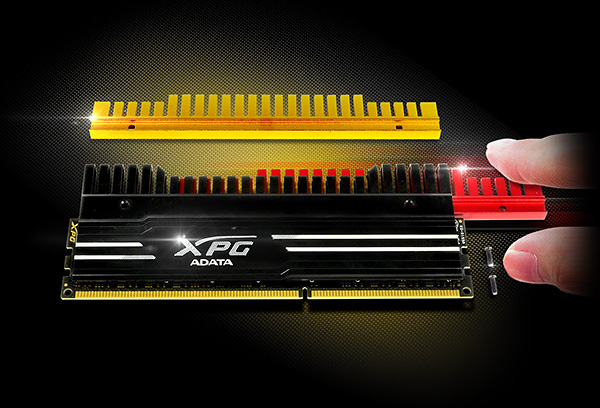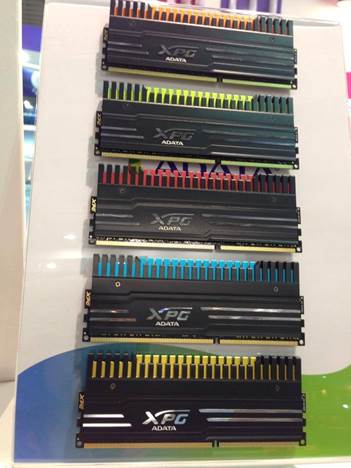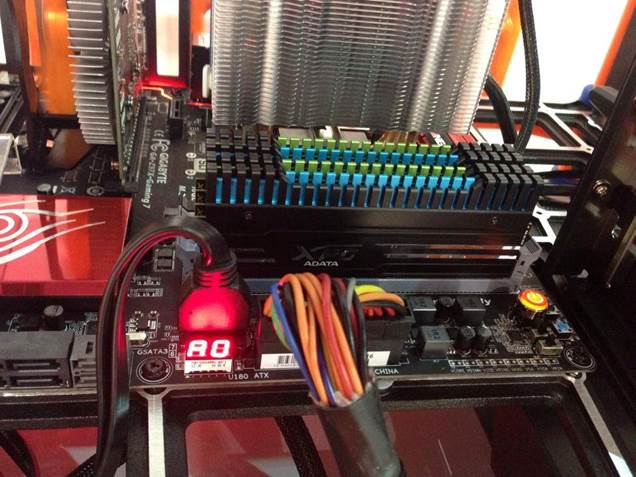ADATA Launches XPG V3 DDR3 Range
by Ian Cutress on July 25, 2014 5:24 AM EST
Despite the talk surrounding the introduction of DDR4 to the market, the volume product for the foreseeable future is still DDR3. We have done a number of memory scaling articles in the past [1,2,3], but due to the resurgence of growth in the gaming segments over the last several quarters, there is still a demand for high speed DRAM, especially those that match the style of the build if the user or gamer wants to show it off at an event. This has caused some of the enthusiast DRAM manufacturers to re-launch their high end modules under new names and new skins, with the option of customization. This lies at the heart of ADATA’s new XPG V3 DDR3 range.
The finned array for the heatsinks can be removed, similar to other high end ranges, and replaced with a custom color. ADATA is saying that the first batches of these modules for retail will include a second set of fins, so users can select between gold and red. There are plans to launch other colors in the future.
Launched SKUs will first be available in gold/red, in either 2x4 GB or 2x8 GB kits, with the following speeds:
DDR3-1600 9-9-9-24 1.50V
DDR3-1866 10-11-11-30 1.50V
DDR3-2133 10-11-11-30 1.65V
DDR3-2400 11-13-13-35 1.65V
DDR3-2600 11-13-13-35 1.65V
DDR3-2800 12-14-14-36 1.65V
DDR3-2933 12-14-14-36 1.65V
DDR3-3100 12-14-14-36 1.65V
All kits will support XMP 1.3, use 8-layer PCBs with 2oz copper to improve signalling, and Thermal Conductive Technology (TCT), which is a fancy way of saying that the DRAM chips themselves are in contact with the heatsink, so the heatsink may be hard to remove depending on the bonding.
With the high frequency modules, it is always worth noting that these are designed for use with Ivy Bridge and Haswell CPUs, and the quality of the memory controller will determine the maximum speed possible. All the Ivy Bridge and Haswell CPUs I have tested, at stock, will easily do DDR3-2933, and should find DDR3-3100 OK as well with a small base frequency overclock. Overclocking the CPU may reduce the peak memory frequency possible, and thus if running an overclocked system, a balance may be needed as well as the expertise/guide to manage that balance. This is true with any high speed memory, not just the ones here, such as our reviews of the TridentX style or ADATA's own XPG V2 DDR3-2800.
ADATA has offered us a review sample which should arrive shortly. Stay tuned for the review. I am currently awaiting a full list of MSRPs and will update the news when it arrives.
Source: ADATA


















18 Comments
View All Comments
LiviuTM - Friday, July 25, 2014 - link
Interesting, it seems like the focus in on highest frequency memory alone.I have a Corsair Vengeance 16 GB kit (2x8) from 2012 with better specs: 1866Mhz 9-10-9-27 at 1.5V.
DanNeely - Friday, July 25, 2014 - link
Once you scale for frequency the faster models all have lower latencies in nanoseconds. The most likely reason the 1600/1866mhz parts fall behind is that as the lowest performing models in the current generation they're where all the worst performing chips are being dumped. 2 years ago 1866 was still a middle of the pack speed.just4U - Monday, July 28, 2014 - link
You know what I want to see? PC 2133 7-7-7 1T.I am not impressed by the high frequencies with no attention paid to latencies. I won't pay a arm and a leg for that.. I will however shell it out for something with high frequencies and timings that come in lower than what you expect to find in most memory kits.
I hope memory makers keep that in mind as they move into DDR4 but so far .. doesn't look like they are.
CaedenV - Friday, July 25, 2014 - link
I really wonder why people spend so much money on RAM like this. I mean I am running 8GB of DR3 1333 and there is not a game I play that is not maxed out at 1080p (or rather 1200p technically). The bottleneck is almost always in the GPU, or CPU when it comes to fps performance issues, and the HDD/SSD when it comes to load times. I mean sure, if you have the money to blow on a toy then go eat your heart out; it just surprises me that there would be much of any real demand for this kind of high speed ram when DDR4 is almost right around the corner.nathanddrews - Friday, July 25, 2014 - link
I know your question is rhetorical, but I'll piggy-back anyway. Why do people buy the i7-4770 vs i7-4771? Why do people buy Titan Black vs 780Ti? Samsung 840 over 830? Lots of products are similar in performance and give very little overall gain, but can make significant differences in specific use cases.Personally, I buy the low-profile memory because I don't need my RAM to be 6" tall.
cmdrdredd - Friday, July 25, 2014 - link
Still rocking my Samsung 30nm ULP memory @ 2133Mhz 10-10-10-28 and 1.47vDeath666Angel - Friday, July 25, 2014 - link
I don't buy the highest rated RAM. But implying that 1333MHz is good enough is weird. Sure, FPS will hardly be impacted (unless you game on an iGPU). But real world performance for stuff like photo and video editing, compression, solvers etc. really scales with RAM speed. And paying 1 or 5% more for RAM (1600 and 1866MHz are often as cheap as 1333MHz these days) is a no brainer to me. As long as they are not too tall. :DMikeMurphy - Friday, July 25, 2014 - link
Why buy 1333mhz when 1600mhz is the same price (or cheaper!) and 20% faster? These high speed chips also work wonders for high-end APUs.pt2501 - Friday, July 25, 2014 - link
To this day my best purchase was 16 GB of G Skill Ripjaws DDR3 2133 with Cas 9 latency at 1.65 V. Say what you will about bandwidth, but when it comes to gaming, there is very little difference between these ultra modules vs midrange memory with tight timings. Price vs performance has always been the reason I visit anandtech.MrSpadge - Friday, July 25, 2014 - link
Almost the same here, Ripjaws 2400 9-11-10 from 2013 when they had a decent price. This bumped my BOINC throughput nicely, for me it's equivalent to a few 100 MHz more on the CPU.